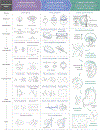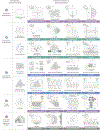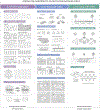Engineering multiscale structural orders for high-fidelity embryoids and organoids
- PMID: 35523138
- PMCID: PMC9097334
- DOI: 10.1016/j.stem.2022.04.003
Engineering multiscale structural orders for high-fidelity embryoids and organoids
Abstract
Embryoids and organoids hold great promise for human biology and medicine. Herein, we discuss conceptual and technological frameworks useful for developing high-fidelity embryoids and organoids that display tissue- and organ-level phenotypes and functions, which are critically needed for decoding developmental programs and improving translational applications. Through dissecting the layers of inputs controlling mammalian embryogenesis, we review recent progress in reconstructing multiscale structural orders in embryoids and organoids. Bioengineering tools useful for multiscale, multimodal structural engineering of tissue- and organ-level cellular organization and microenvironment are also discussed to present integrative, bioengineering-directed approaches to achieve next-generation, high-fidelity embryoids and organoids.
Keywords: developmental biology; embryoid; mammalian embryogenesis; mechanobiology; organoid; stem cell engineering.
Copyright © 2022 Elsevier Inc. All rights reserved.
Conflict of interest statement
Declaration of interests The authors declare no competing interests.
Figures




References
-
- Ahadian S, Yamada S, Ramon-Azcon J, Ino K, Shiku H, Khademhosseini A and Matsue T (2014). Rapid and high-throughput formation of 3D embryoid bodies in hydrogels using the dielectrophoresis technique. Lab Chip 14, 3690–3694. - PubMed
-
- Al Tanoury Z, Zimmerman JF, Rao J, Sieiro D, McNamara HM, Cherrier T, Rodriguez-delaRosa A, Hick-Colin A, Bousson F, Fugier-Schmucker C, et al. (2021). Prednisolone rescues Duchenne muscular dystrophy phenotypes in human pluripotent stem cell-derived skeletal muscle in vitro. Proc. Natl. Acad. Sci. U. S. A 118, e2022960118. - PMC - PubMed
-
- Allazetta S, Cosson S and Lutolf MP (2011). Programmable microfluidic patterning of protein gradients on hydrogels. Chem. Commun 47, 191–193. - PubMed
Publication types
MeSH terms
Grants and funding
LinkOut - more resources
Full Text Sources

